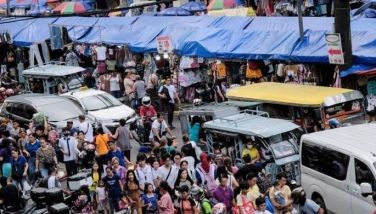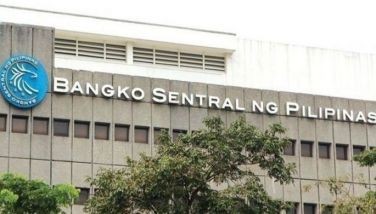The Pinoy middle class

The circus has come to town. And the clowns have filled their certificates of candidacies. Imagine having our country led by these clowns. Judging from social media comments, I detect a sense of despair coming from the middle class, summed up by the phrase: we deserve better.
Indeed, the nation deserves better. But our political system is badly broken. Good intentions of those who framed the Constitution, like the party-list, have been bastardized. Washed up showbiz types who no longer have box office appeal are rushing to become senators because they need a source of income. The rest comes from political dynasties.
I saw a meme on Facebook that is so true: “No country can progress if its politics is more profitable than its industries. In a country where those in government are richer than entrepreneurs, they manufacture poverty.”
That’s our story. Dynastic politics is the country’s biggest industry. Unfortunately, it is an onerous economic burden to carry.
The Filipino middle class seems to be feeling a little more agitated than usual and for good reason: our future in a more competitive world is being sacrificed by bad governance. The last time I felt that middle class angst was during the years leading to the 1986 EDSA People Power revolution. You could feel it in the air that the country was ripe for change.
And when yellow strips of paper started to fall down from buildings around the Makati business district, there was this sense of belonging to a cause larger than ourselves. That culminated in the People Power revolution. The movement led by the Filipino middle class was able to assert its collective power against the ruling elite. Even the natdems on the extreme left were caught by surprise.
But the middle class had no staying power. It eventually allowed the traditional social elites represented by the oligarchic families to hijack potential gains that could have resulted in a better society. In the years that followed, disillusioned members of the middle class merely voted with their feet and migrated to countries whose governance features more clearly promised a brighter future for their children.
This time around, the middle class seems to be just waiting for a leader they can trust. Many of them thought it was Leni Robredo. The pink revolution before the last presidential election gave the same feeling of national purpose that People Power had. But so much cynicism permeated most of our society and that denied the movement the necessary momentum to succeed.
What is the middle class vision of a just Philippine society? The supposedly collective vision and aspiration called AmBisyon Natin captures it: By 2040, the country will feature a prosperous, predominantly middle class society where poverty will have been eradicated and where smart and innovative Filipinos thrive in a high-trust society that allows them to live long and healthy lives.
But that’s just the economic nerds at NEDA trying to capture into words what ought to be our national vision. And the foundation of that vision is a thriving middle class. We are nowhere near that. And the middle class is under threat by the policies of a succession of administrations. Our government takes care of the masa who keep on voting for clowns and political dynasties. The middle class is left to fend for themselves.
Who is middle class? Essentially, they are well-educated people, such as doctors, lawyers, military and police officers, accountants, engineers and middle level government bureaucrats who have good jobs and are not poor, but are not rich. OFWs and MSME entrepreneurs are also middle class.
Government statisticians define the middle-class as those earning incomes between two and 12 times the poverty line. This means if your monthly family income is between around P24,000 and P145,000, you are middle class. Around 47.4 percent of Filipino families or 39.8 percent of the population were middle-income in 2021. Only around 1.5 percent of Filipino families or one percent of the population were high-income in 2021. Low-income families comprised the majority in 2021 at 51.1 percent of families or 59.2 percent of persons.
The middle class is the source of economic growth. A strong middle class provides a stable consumer base that drives productive investment. SM of the Sy-blings wouldn’t have become as big as it is without the middle-class.
Dr. Jose Ramon Albert pointed out that this segment plays a critical role in socioeconomic growth due to their access to higher education and income.
But Dr Albert also sees this growing demographic threatened. “Many middle class households have experienced job losses, reduced incomes and increased expenditure on education and health.”
Marco Sardillo III, executive director of Asia Society Philippines, underscored the apparent vulnerability of the middle class, particularly during crises such as the COVID-19 pandemic. “The assumption is that the oligarchs are invested in our politicians, and they look after the poor. It is the middle class that is left to their own devices.”
NEDA Undersecretary Rosemarie Edillon highlighted the importance of social protection to ensure the welfare and sustained growth of the middle class.
Yes. The middle class needs social protection too. They are left out in most government social protection programs. The middle class is the main source of taxes but gets little in return. The middle class, for example, carries a large burden for healthcare, which is very expensive in this country. PhilHealth was designed to help the poor and even at that, it barely helps.
Next year’s election will show if the middle class can mobilize and make its presence felt. If votes for Leni, diluted as that might have been, can stick together this May, they have a good chance of electing at least two senators, Kiko Pangilinan and Bam Aquino. Hopefully, they were not too disheartened by the experience with Comelec so as to give up totally on our country’s potential for salvation.
Boo Chanco’s email address is [email protected]. Follow him on X @boochanco.
- Latest
- Trending






























